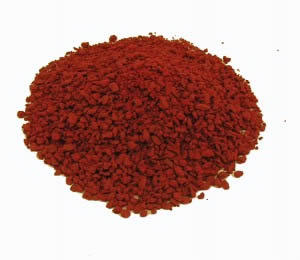Astaxanthin (AST) is a xanthophyll carotenoid of usually marine origin, with strong antioxidant and anti-inflammatory properties showed in both experimental and human studies. It is found in living organisms especially in the marine environment where it is present in microalgae, plankton, krill and seafood. It gives trout, salmon, and crustaceans such as lobster and shrimp their distinctive reddish coloration.
Astaxanthin and Inflammation
Natural astaxanthin works to suppress varied inflammatory mediators. Astaxanthin not only affects the cyclooxygenase-2 (COX 2) pathway, it suppresses serum levels of nitric oxide (NO), prostaglandin E2 (PGE-2), interleukin 1B (IL-1b), CRP (C Reactive Protein) and tumor necrosis factor alpha (TNF-a), and all of this has been shown.
In one experiment done with mice and in-vitro, astaxanthin was proven to suppress tumor necrosis factor alpha (TNF-a), interleukin 1B (IL-1b), prostaglandin E-2 (PGE-2), nitric oxide (NO) as well as the Cox-2 enzyme and nuclear factor kappa-B. In another study; found similar findings. Astaxanthin was shown in vitro to reduce the production of TNF-a, PGE-2 and nitric oxide. Two randomized, placebo-controlled study were performed on human volunteers to assess the effect of supplementation with an astaxanthin-rich algal extract on symptoms associated with the inflammatory diseases RA (rheumatoid arthritis) and CTS (carpal tunnel syndrome). The results revealed that astaxanthin significantly relieve pain and improved performance in patients with rheumatoid arthritis; the results on carpal tunnel syndrome patients were similar.
 The most common test for silent inflammation is a measurement of blood levels of a substance called CRP (C-reactive protein). C-reactive protein is produced in the liver and in the coronary arteries, and is then released into the bloodstream when the body is fighting inflammation. In 2006, a clinical study analyzed the effects of astaxanthin on blood CRP levels. Sixteen participant received astaxanthin and nine received a placebo. Blood CRP levels were measured before the participants began the astaxanthin, and again at the end of the study. The study lasted for 8 weeks. At the end of the study, the treatment group experienced a 20 % diminution in CRP levels in 8 weeks, while the placebo group saw an increase in their levels. Another study on the effects of astaxanthin on CRP was reported in 2006. This study particularly used people with elevated CRP levels that would put them in a high risk category. After 3 months in the ongoing study, 43% of the astaxanthin group experienced enough of a diminution in their blood CRP levels to fall out of the high risk category and into the average risk group. Close to half of the participants returned their CRP levels from high risk to normal by supplementing their diets with astaxanthin.
The most common test for silent inflammation is a measurement of blood levels of a substance called CRP (C-reactive protein). C-reactive protein is produced in the liver and in the coronary arteries, and is then released into the bloodstream when the body is fighting inflammation. In 2006, a clinical study analyzed the effects of astaxanthin on blood CRP levels. Sixteen participant received astaxanthin and nine received a placebo. Blood CRP levels were measured before the participants began the astaxanthin, and again at the end of the study. The study lasted for 8 weeks. At the end of the study, the treatment group experienced a 20 % diminution in CRP levels in 8 weeks, while the placebo group saw an increase in their levels. Another study on the effects of astaxanthin on CRP was reported in 2006. This study particularly used people with elevated CRP levels that would put them in a high risk category. After 3 months in the ongoing study, 43% of the astaxanthin group experienced enough of a diminution in their blood CRP levels to fall out of the high risk category and into the average risk group. Close to half of the participants returned their CRP levels from high risk to normal by supplementing their diets with astaxanthin.
Scientists explored the effect of a astaxanthin on the gripping strength of tennis elbow patients. The study involved 33 participants; the astaxanthin group (twenty-one people) and the placebo group (twelve people). After 8 weeks the treatment (astaxanthin) group displayed a remarkable improvement in average gripping force of 93%, and there was a reduction in self-assessed pain. A questionnaire answered by 247 users of astaxanthin supplementation demonstrated that more than 80% of those complaining on back pain and having symptoms of rheumatoid arthritis or osteoarthritis reported an improvement through the use of astaxanthin. The clinical study done on carpal tunnel syndrome sufferers was done with 20 participant, 13 in the treatment group and 7 in the placebo group over an 8 week period. The result demonstrated that the group taking astaxanthin reported a 27% diminution in daytime pain after four weeks and a 41% diminution after eightweeks. Also, the duration of daytime pain decreased by 21% after 4 weeks and 36% after 8 weeks. In a study featured 21 participants, 14 receiving astaxanthin and 7 receiving a placebo. Duration of the study was 8 weeks. The results demonstrated a important difference both in pain and satisfaction scores between the astaxanthin and control groups at the end of the study. Pain scores for the astaxanthin group reduction by about 10% after 4 weeks, and by more than 35% after 8 weeks. The investigators concluded that “Astaxanthin supplements appear to be an effective addition in the therapy of rheumatoid arthritis and further studies should be carried out with a largerpopulation”.
Leave a Reply